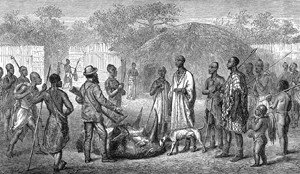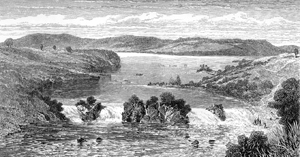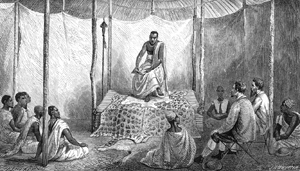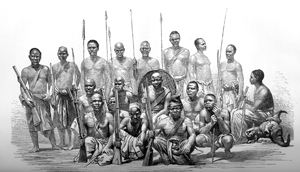Country of Moon
U-n-ya-mŭézi — Country of Moon — must have been one of the largest kingdoms in Africa. It is little inferior in size to England, and of much the same shape, though now, instead of being united, it is cut up into petty states. In its northern extremities it is known by the appellation U-sŭkŭma—country north; and in the southern, U-takama—country south. There are no historical traditions known to the people; neither was anything ever written concerning their country, as far as we know, until the Hindŭs, who traded with the east coast of Africa, opened commercial dealings with its people in slaves and ivory, possibly some time prior to the birth of our Saviour, when, associated with their name, Men of the Moon, sprang into existence the Mountains of the Moon. These Men of the Moon are hereditarily the greatest traders in Africa, and are the only people who, for love of barter and change, will leave their own country as porters and go to the coast, and they do so with as much zest as our country-folk go to a fair. As far back as we can trace they have done this, and they still do it as heretofore. The whole of their country ranges from 3000 to 4000 feet above the sea-level—a high plateau, studded with little outcropping hills of granite. . . .
—Speke (pp. 84-85)

“Arms and Fashions of Uganda”
The Wanyamŭézi . . . women, generally, are better dressed than the men. Cloths fastened round under the arms are their national costume, along with a necklace of beads, large brass or copper wire armlets, and a profusion of thin circles, called sambo, made of the giraffe’s tail-hairs bound round by the thinnest iron or copper wire; whilst the men at home wear loin-cloths, but in the field, or whilst travelling, simply hang a goat-skin over their shoulders, exposing at least three-fourths of their body in a rather indecorous manner. In all other respects they ornament themselves like the women, only, instead of a long coil of wire wound up the arm, they content themselves with having massive rings of copper or brass on the wrist; and they carry for arms a spear and bow and arrows. All extract more or less their lower incisors, and cut a ^ between their two upper incisors. The whole tribe are desperate smokers, and greatly given to drink. [pp. 85-86]
“Grant Dancing with Ukulima”
Marching slowly, as my men kept falling sick, I did not reach Grant again until the 11th. His health had greatly improved, and he had been dancing with Ukßlima [a village chief], as may be seen by the accompanying woodcut. [p. 138]

“Presenting My Spoils to Rumankia. Heads of Three White Rhinoceros Shot in Kerague”
. . . [I]n another dense thicket, near the head of a glen, I came upon three, who no sooner sighted me, than all in line they charged down my way. Fortunately at the time my gun-bearers were with me; so, jumping to one side, I struck them all three in turn. One of them dropped dead a little way on; but the others only pulled up when they arrived at the bottom. To please myself now I had done quite enough; but as the princes would have it, I went on with the chase. As one of the two, I could see, had one of his fore-legs broken, I went at the sounder one, and gave him another shot, which simply induced him to walk over the lower end of the hill. Then turning to the last one, which could not escape, I asked the Wanyambo to polish him off with their spears and arrows, that I might see their mode of sport. As we moved up to the animal, he kept charging with such impetuous fury, they could not go into him; so I gave him a second ball, which brought him to anchor. In this helpless state the men set at him in earnest, and a more barbarous finale I never did witness. . . . The day’s sport was now ended, so I went home to breakfast, leaving instructions that the heads should be cut off and sent to the king as a trophy of what the white man could do. [p. 229]

“The Ripon Falls—the Nile Flowing Out of Victoria N’yanza”
At last, with a good push for it, crossing the hills and threading huge grasses, as well as extensive village plantations lately devastated by elephants—they had eaten all that was eatable, and what would not serve for food they had destroyed with their trunks, not one plantain or hut being left entire—we arrived at the extreme end of the journey, the farthest point ever visited by the expedition on the same parallel of latitude as king Mtésa’s palace, and just forty miles east of it. We were well rewarded; for the “stones,” as the Waganda call the falls, was by far the most interesting sight I had seen in Africa. Everybody ran to see them at once, though the march had been long and fatiguing, and even my sketch-book was called into play. Though beautiful, the scene was not exactly what I expected; for the broad surface of the lake was shut out from view by a spur of hill, and the falls, about 12 feet deep, and 400 to 500 feet broad, were broken by rocks. Still it was a sight that attracted one to it for hours—the roar of the waters, the thousands of passenger-fish, leaping at the falls with all their might, the Wasoga and Waganda fishermen coming out in boats and taking post on all the rocks with rod and hook, hippopotami and crocodiles lying sleepily on the water, the ferry at work above the falls, and cattle driven down to drink at the margin of the lake,—made, in all, with the pretty nature of the country—small hills, grassy-topped, with trees in the folds, and gardens on the lower slopes—as interesting picture as one could wish to see. The expedition had now performed its functions. I saw that old father Nile without any doubt rises in the Victoria N’yanza, and, as I had foretold, that lake is the great source of the holy river which cradled the first expounder of our religious belief. [pp. 466-467; italics added]

“Kamrasi’s First Lesson in the Bible”
29th. [October 1862]— To-day I met Kamrasi at his new reception-palace on this side of the Kafß — taking a Bible to explain all I fancied I knew about the origin and present condition of the Wahßma branch of the Ethiopians, beginning with Adam, to show how it was the king had heard by tradition that at one time the people of his race were half white and half black. Then, proceeding from the Flood, I pointed out that the Europeans remained white, retaining Japhet’s blood; whilst the Arabs are tawny, after Shem; and the Africans black, after Ham. . . . [I explained] the way in which the type or physical features of people undergo great changes by interbreeding. . . . This amused Kamrasi greatly. . . . [pp. 546-47]

“Speke’s ‘Faithfuls’”
I hope the reader who has followed my narrative thus far will be interested in knowing how “my faithful children,” for whose services I had no further occasion, and whom I had taken so far from their own country, were disposed of. At Cairo, where we put up in Shepherd’s Hotel, I had the whole of them photographed, and indulged them at the public concerts, tableaux vivants, &c. By invitation, we called on the Viceroy at his Rhoda Island palace, and were much gratified with the reception; for, after hearing all our stories with marked intelligence, he most graciously offered to assist me in any other undertaking which would assist to open up and develop the interior of Africa. I next appointed Bombay captain of the “faithfuls,” and gave him three photographs of all the eighteen men and three more of the four women, to give one of each to our Consuls at Suez, Aden, and Zanzibar, by which they might be recognised. I also gave them increased wages, equal to three years’ pay each, by orders on Zanzibar, which was one in addition to their time of service; and order for a grand “freeman’s garden,” to be purchased for them at Zanzibar; and an order that each should receive ten dollars dowry-money as soon as he could find a wife. With these letters in their hands, I made arrangements with our Consul, Mr Drummond Hay, to frank them through Suez, Aden, and the Seychelles to Zanzibar. . . . Further, they all volunteered to go with me again, should I attempt to cross Africa from east to west, through the fertile zone. [pp. 611-12]
